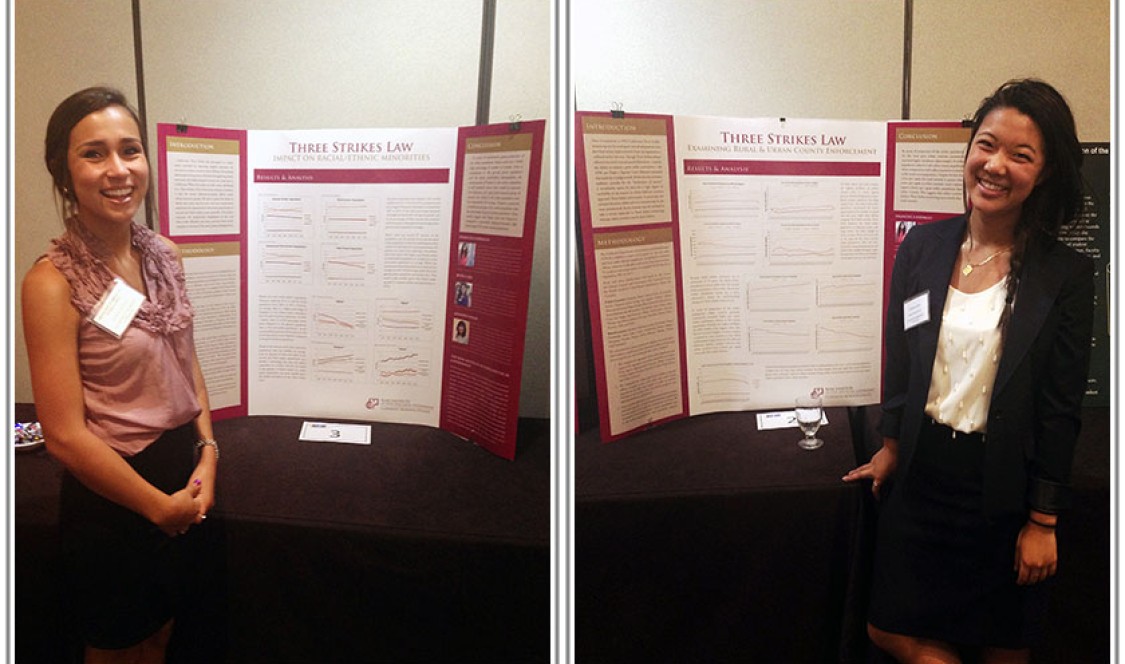Rose Institute of State and Local Government research assistants Francesca Hidalgo-Wohlleben ’17 and Jessica Jin ’16 took 1st and 2nd place, respectively, for presentations related to second- and third-striker prison population data at the Association for Criminal Justice Research (ACJR) (California) conference on “Criminal Justice in a Community Perspective” March 26-27 in Sacramento.
Hidalgo-Wohlleben (a Philosophy, Politics, and Economics major) and Jin (an Art-Government dual major) took part in the conference’s Student Poster Contest, which allowed undergraduate and graduate students to present research on criminal justice topics.
“Each of us created a poster to present our research about the Three Strikes law in California,” Hidalgo-Wohlleben said. “Over the past year, we have worked (with a few other Rose research assistants as well) to compile a data set of more than 400,000 data points about the striker prison population. In the last month or so, we've used the data to evaluate a few questions concerning the data. I looked at the racial/ethnic breakdown of the striker population from 2001 to 2013 and presented this information graphically.”
According to Jin, in light of recent realignment, the future of California's criminal justice system and practices are in need of significant reform. “It's important to analyze our current system in order to understand in what manner we need to change the criminal justice process for the better,” she said.
The project has been on-going since last year. Last fall, CMC students Andrew Nam ‘15 and Elena Lopez ‘15 sent in their poster to a similar conference hosted by ACJR. At this conference the same data was used from last year but different questions were applied.
Nam, who acted as student manager of the project this year said the following questions were addressed:
- Which county is responsible for the most two- and three-strikers (per capita) for each offense category?;
- How do rural counties differ from urban counties with regard to two-and three-strike sentences for each offense category (crimes against persons, property crimes, and drug crimes)?; and
- What is the racial/ethnic breakdown of two- and three-strike offenders? How has this changed over time? How does this compare to the rest of the state's demographics vis-a- vis other inmates and the state prison population? To what extent are racial/ethnic minorities overrepresented?
“Through the help of Francesca, Jessica, and Katie Hill ‘18 (who was added to the team middle of this semester), we were able to wrap up these reports based on the database we gathered,” Nam said. “This is the first database on Three Strikes that allows users to run analysis easily.”
Hidalgo-Wohlleben said that in her poster, the most interesting finding was that African-Americans make up a very notably high percentage of the striker population in comparison to the general prison population and California's population.
“However, such a trend did not exist in the striker population for the Hispanic population, as they made up a smaller percentage of the striker population than Hispanics do in the general prison population,” she said.
Jin also pointed to the Three Strikes Law's disproportionate conviction of black offenders as the most remarkable finding of her study. “It is significant and indisputably indicates that the law impacts African-Americans more than any other race or ethnicity,” she said. “Hopefully, the presentations will call attention to the Three Strikes Law. In light of the law’s 20th anniversary, it's important that legislators take a close look at California's mandatory sentencing rules in order to consider the efficacy of such guidelines.”
Both women credit the Rose Institute as invaluable in shaping their experience at CMC. “The opportunity to conduct meaningful research via the Institute has allowed me to explore some of the most pressing questions of today,” Jin said.
Hidalgo-Wohlleben and Jin also cited Jennifer Walsh of Azusa Pacific University and a Rose Institute Faculty member for her guidance and mentoring.
The ACJR (California) is a mix of public servants, practitioners, evaluators, analysts, students, and academics united by a common interest in criminal justice issues. The Association seeks to stimulate discussion of current criminal justice issues. Analysts, academics and practitioners meet to hear energetic presentations at bi-annual conferences.
##

